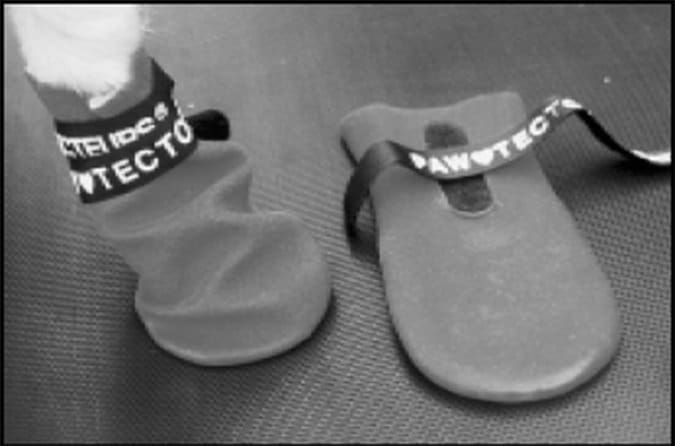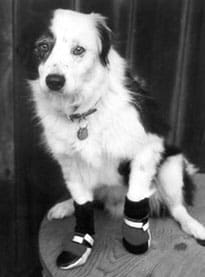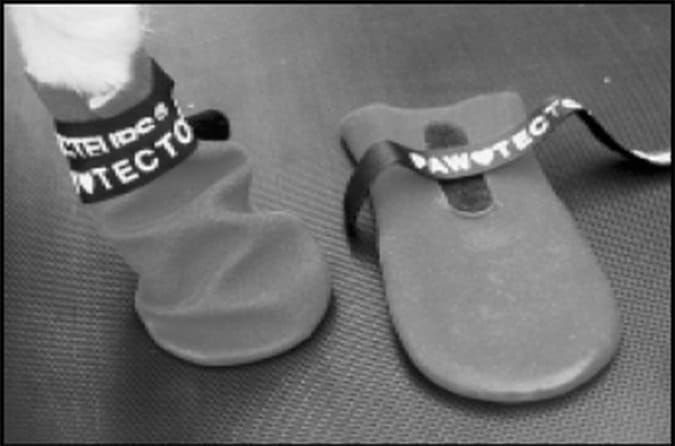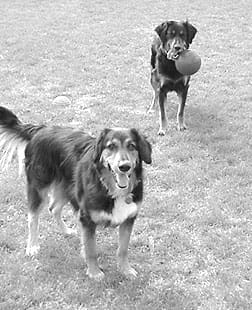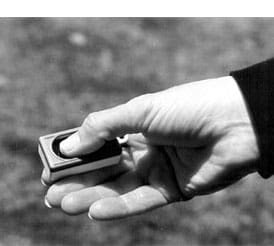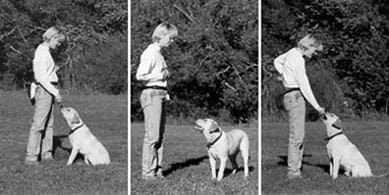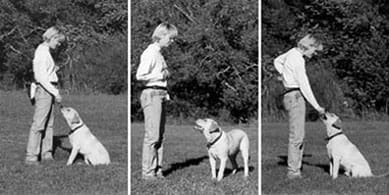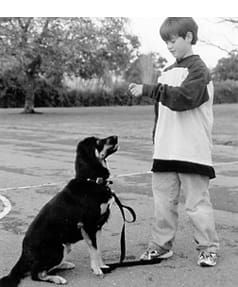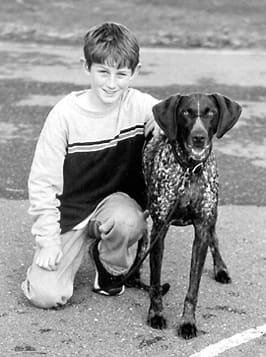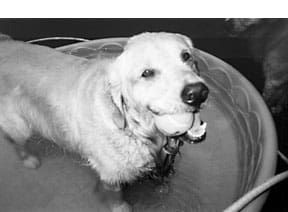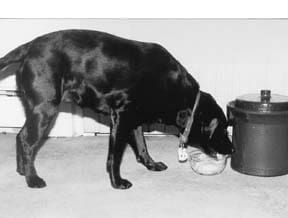When Dee (Ch. Antren’s Dearest Jaegerin) jumped onto her owner’s bed last May, she slipped and fell flat on her back. The 10-year-old, 98-pound Rottweiler scrambled to her feet and seemed fine, but a few hours later, her hind legs collapsed. “They just buckled,” says her owner, Kathy Signorile. “We were on our afternoon walk here in rural Pennsylvania, and suddenly Dee couldn’t move. After a few minutes she took a few steps, but then she had to sit down again. It took forever to get back to the house, and it was really scary.” X-rays taken the following day showed that Dee’s hips and legs were exceptionally healthy for a dog her age and size. “The problem was the area along her spine just above the hip joint, which by then was noticeably tender and swollen,” says Kathy. “The veterinarian told us she had probably suffered nerve damage and that there wasn’t anything we could do but watch and wait.”

That was difficult for all concerned. “Dee had always been an active dog,” says Kathy. “She loved to play, go for walks, and take long rides in the car. She had been a therapy dog for five years, visiting hospitals and nursing homes, and she had just won an award from the Colonial Rottweiler Club for therapy dog of the year. Now, in addition to being in constant pain, she was losing interest in the world around her. Unless my husband and I lifted her, she couldn’t get up. We put her in a harness to take her outside, but even with our help she could barely manage the walk to the yard. Sometimes she’d fall over, and we had to pull her up. We began to consider the possibility that Dee would never recover.”
Dee obviously became the main topic of conversation between the Signoriles and their friends, and it was this support network that was responsible for leading the concerned couple to a solution to Dee’s problems. One of their friends had read about systemic oral enzyme therapy, and suggested that they try the product mentioned in the article, a German product called Wobenzym N, which is sold in American health food stores. Therapeutic doses of the digestive enzymes are taken between meals on an empty stomach.
Two weeks after Dee’s accident, the Signoriles began giving the dog five Wobenzym tablets twice a day. Within just a few days, they noticed an improvement. “She moved a little more comfortably,” says Kathy, “and every time we took her out, I got her to walk a little farther. She had been sleeping in the same spot by the sofa day after day, but one afternoon she surprised us by not being there. She had moved to a different side of the room. Then she walked by herself onto the back porch. We were thrilled. Dee was showing signs of life.” Their daily outings grew longer, and three weeks after beginning the enzyme therapy, Dee walked a mile. Soon she was strolling three miles with ease, and one day, Kathy found her lying on the bed she had originally fallen from. “We couldn’t believe it,” Kathy says. “It seemed like a miracle. By mid-July, which was two months after her accident and six weeks after she started taking enzymes, Dee was not only completely well, she was healthier than she’d been in years.”
What’s An Enzyme?
Enzymes are protein-like compounds that, in small amounts, speed the rate of biological reactions. Unstable, fragile, and easily inactivated, enzymes are produced within living cells to perform specific biochemical reactions. Enzymes exist in plants as well as animals. Without them, life as we know it would not exist. Enzymes cause seeds to sprout, flowers to blossom, plants to grow, autumn leaves to change color, and fruits to ripen. Enzymes play a vital role in the fermentation of foods such as cheese, kefir, yogurt, sauerkraut, and soy sauce. Many enzymes are cultivated for use in industrial processes, medical testing, food production, and as ingredients in household products such as pet stain removers, laundry detergents, toothpaste, and facial cleansers. Living animals manufacture thousands of enzymes for various functions throughout their bodies.
Metabolic Improvements
Two of the most important types of enzymes are metabolic enzymes, which operate throughout the body, and digestive enzymes, which stimulate biochemical reactions in the stomach and intestines. Nearly every raw food carries within it the enzymes necessary for its digestion, as well as metabolic enzymes, but cooking, baking, pasteurization, frying, high-temperature drying, and boiling destroy them.
Like humans, dogs and cats that eat mostly cooked or processed food consume few if any enzymes, and must manufacture the substances themselves. Proponents of enzyme therapy believe that supplemental enzymes can benefit the body in two important ways: They can spare the body the effort of producing enzymes, and they can initiate improved cellular function in every body system.
Dr. Edward Howell, author of Enzyme Nutrition: The Food Enzyme Concept, forwarded the theory that when a person or animal eats food that does not contain enzymes, forcing the body to manufacture the enzymes needed for digestion and other functions, it is as if the body must make a withdrawal from its enzyme bank. The more withdrawals that are made without compensating deposits, the faster the enzyme bank is depleted. Dr. Howell believed that health itself depends on the efficient action of metabolic enzymes, and providing the body with fuel that spares its metabolic enzymes can be a key to maintaining good health.
Metabolic enzymes do all the structuring, repair, and remodeling in every cell, organ, and tissue. When metabolic enzymes decline in number, Howell speculated, the aging process accelerates. Dr. Howell observed that dogs and cats in the wild do not produce enzymes in their saliva – ostensibly because their raw diets include adequate enzymes. He also learned that dogs switched from raw food to a high-carbohydrate, heat-treated diet begin to produce enzymes in their saliva within about a week. He theorized that the manufacture of these enzymes may cost these animals enzymes they may need at a later date for metabolic functions. “The remarkable thing about the eventual bankruptcy of the enzyme account,” wrote Howell, “is that it can proceed quite painlessly, without immediate symptoms.”
The digestion of food takes a high priority and acts as a powerful stimulus in the demand for enzymes. If the function of digestion takes more than its rightful share, other organs and tissues must manage with the remaining capacity. This, he explained, is how many illnesses and ailments begin.
Many holistic veterinarians agree with the theory. “Young bodies can compensate for a lack of enzymes in the food they eat, but enzyme production declines with age. Older dogs and cats benefit from enzyme supplements, which improve digestion, tissue repair, and inflammatory conditions like arthritis,” says Beverly Cappel, DVM, a holistic veterinarian in Chestnut Ridge, New York. “Animals of all ages benefit from enzyme therapy for injuries, wound healing, and serious illnesses.”
In New Hampshire, one of Susan Appelin’s Greyhounds had part of a rib removed to treat a hemangiosarcoma, but the tumor grew back. Another Greyhound was diagnosed with a mast cell sarcoma. “These cancers are almost always fatal,” she says, “and my veterinarian gave me no hope for the dogs’ survival. I decided I would not give up and prayed for guidance.” When a holistic physician told her about Wobenzym N, she added between-meal enzymes to a regimen of vitamins and home-prepared food for her dogs. “Eighteen months ago, the dog with the hemangiosarcoma was given 30 days to live,” she says, “but thanks to Wobenzym, his tumor shrank and disappeared. The other dog has been in remission for 12 months. I now have all four of my Greyhounds and five cats on Wobenzym.”
Digestive Enzyme Supplements
The use of enzyme supplements that specifically assist digestion is fairly well known and utilized among dog caretakers – much more so than metabolic enzyme supplementation – perhaps because proper digestion affects the body’s overall health in such profound ways. “Incomplete digestion allows partially digested particles to be reabsorbed into the bloodstream from the large intestine, creating immune dysfunction, inflammation, allergies, and other problems,” says Dr. Cappel. Veterinarians and pet owners who supplement their dogs’ food with Prozyme, a popular digestive enzyme supplement, typically report improved skin and coat, increased stamina, improved immune system response, fewer allergies, faster wound healing, improved digestion, stronger joints, and increased range of motion. The most commonly reported side effect is that dogs often gain weight when Prozyme is added to their food. In underweight dogs, this is an asset. In previously normal-weight dogs, serving portions may have to be reduced by up to 15 percent as the dog’s digestion becomes more and more efficient. Research has shown that Prozyme increases the absorption of essential nutrients, especially zinc, selenium, vitamin B6, and linoleic acid, from pet food. Digestive enzyme supplements abound; just go look in your local health food store. Plant-derived enzymes include protease, which digests protein; lipase, an upper digestive tract enzyme that breaks down fats or lipids; and amylase, a saliva enzyme that digests starch or carbohydrates. Proteases, or proteolytic enzymes, include many different enzymes, each of which breaks down a specific amino acid found in protein. Lipases, or lipolytic enzymes, digest lipids (oils and fats), including phospholipids such as lecithin, sterols such as cholesterol, and triglycerides. Amylases, or amylytic enzymes, interact with carbohydrates, including lactose, a sugar in milk; fructose, a simple sugar found in honey and sweet fruits; starches, which occur in almost all plant foods, especially grains; and sucrose, the disaccharide found in cane sugar and beet sugar, which contains fructose and glucose. Pancreatic enzyme supplements are usually derived from pigs or cattle. Pancreatin contains many enzymes, including protease, lipase, and amylase. It works in the small intestine, where it assists in the digestion of protein, fats, and carbohydrates. Most digestive enzyme products utilize protease, amylase, and lipase. Some brands also include hydrochloric acid, pepsin, ox bile, papain from papaya, cellulose-digesting enzymes, bromelain from pineapple, and other ingredients. Enzyme supplements are sold as powders, capsules, or tablets. Tablets labeled “coated” or “enteric-coated” are protected by an acid-resistant shell that passes through the stomach undigested and breaks apart in the intestines.
Systemic Oral Enzyme Therapy
When taken with food, digestive enzymes improve the food’s breakdown and assimilation. When taken on an empty stomach between meals, the same enzymes are carried by the blood throughout the body, hence the term “systemic.” Instead of addressing a single function, such as digestion or circulation, systemic therapies have a tonic effect on the entire body, helping it heal itself from within. Proteolytic enzymes taken between meals correct a host of illnesses and imbalances by degrading protein molecules that have penetrated tissue, resulting in edema and inflammation; in addition, they increase the flexibility of red blood cells, improving the flow of blood through the arteries and inhibiting platelet aggregation, which helps prevent abnormal clotting. The same enzymes stimulate the immune system by activating macrophages and natural killer (NK) cells. Cellular debris is removed more efficiently, cleansing tissue, improving circulation, and stimulating the growth of healthy new cells. In research conducted on boxers (human athletes, not the dog breed!), bromelain was shown to significantly reduce swelling and bruising from trauma injuries and speed wound healing. Papain has proven anti-inflammatory and wound-healing properties. Pancreatin taken on an empty stomach reduces inflammation and pain throughout the body and helps eliminate intestinal parasites by literally digesting them. Other enzymes reduce inflammation, improve immune function, and stimulate the digestion of bacteria, toxins, and incompletely digested proteins, cleansing the lymph and blood of problem-causing particles. Digestive enzymes taken at night, several hours after dinner, help relieve food sensitivities, hay fever allergies, and insomnia caused by reactions to food. In dozens of clinical trials in which systemic oral enzymes were compared to prescription drugs or other conventional therapies, patients taking oral enzymes experienced comparable or superior results. European athletes on systemic oral enzyme therapy have recovered quickly from sports injuries. In addition, enzymes increase the effectiveness of prescription drugs, such as antibiotics, when they are taken together. Many enzyme supplements sold as digestive aids can be taken between meals to help speed healing. Single-enzyme products include bromelain, pancreatin, and papain. Most health food stores offer several brands of each as well as blends containing these and other ingredients. Note: Products containing hydrochloric acid (HCl), sometimes labeled betain hydrochloride, should not be taken on an empty stomach unless recommended for between-meal use on the label. In Europe, systemic oral enzyme therapy is often used in place of aspirin and other nonsteroidal anti-inflammatory drugs (NSAIDs), including ibuprofen, phenylbutazone, and diclofenac. Dr. Cappel is one of the growing number of American veterinarians who recommend enzymes for their anti-inflammatory effect in dogs and cats. “It’s ironic,” she says, “but both steroidal and nonsteroidal anti-inflammatory drugs actually cause degeneration. They temporarily suppress symptoms such as pain, swelling, tenderness, and inflammation, but they don’t correct the cause of these problems. In fact, they make it worse. Enzymes are wonderful for pets because they don’t have adverse side effects, and they address the cause of inflammation, so the body heals itself.” David Steinman, enzyme authority and publisher of The Doctors’ Prescription for Healthy Living newsletter, agrees. “There is a big push by the pharmaceutical industry to market NSAIDs for pets,” he says, “but European studies show that NSAIDs are, after vaccines, the leading cause of treatment-related death in dogs. Enzymes stimulate the regeneration of damaged tissue, so they don’t just mask the problem, they actually repair it.” In addition to using systemic oral enzyme therapy for injuries, arthritis, auto-immune diseases, cardiovascular disease, and all types of digestive problems, Dr. Cappel prescribes enzyme supplements for cancer patients. “Large doses of pancreatic enzymes have been used with human cancer patients for decades,” she says. “Dogs with cancer often respond well to this treatment.” The German product Wobe-Mugos, made by Wobenzym’s manufacturer, has orphan drug status in the United States for multiple myeloma because it prolongs survival. The Orphan Drug Act of 1983 allows the marketing of drugs used to treat rare diseases, for which there is little potential for profit, even if they have not been tested according to U.S. Food and Drug Administration protocols. FDA requirements are waived for these drugs. Wobe-Mugos contains concentrated trypsin, chymotrypsin, and papain. The usual comparison is that one Wobe-Mugos tablet equals three or four Wobenzym tablets.
Enzyme Dosage for Dogs
For effective systemic oral enzyme therapy, enzymes should be taken at least 45 minutes to one hour before meals or at least one to two hours after. When adapting over-the-counter enzyme products for canine use, consider your dog’s weight. Label directions are appropriate for a 100-pound human, so adjust accordingly. Considering the well-documented safety of enzyme products (note cautions below before using), proportions can be approximate. For dogs over 80 pounds, the human dose is likely to be effective and well tolerated. For dogs weighing 50 pounds, cut dosage in half; for those weighing 25 pounds, use 1/4 the recommended amount. Most product labels list a maintenance dose for everyday use. Labels on single-ingredient products like bromelain and pancreatin give dosages for use with food. In addition to using these enzymes with food, the same dosage twice or three times per day between meals is appropriate for systemic therapy. Experts disagree as to whether enteric-coated tablets taken between meals work better than capsules; uncoated pancreatin and bromelain have been shown to be effective by themselves. Some dog owners use all three strategies – enzymes with food, uncoated enzymes between meals, and enteric-coated enzymes between meals – to be sure their dogs receive all the support they need, especially while recovering from a serious illness or injury.
Cautions and Side Effects
Oral enzyme products can be problematic for any dog that is allergic to beef, pork, papaya, pineapple, Aspergillus oryzae, or other food-source ingredients. If your dog has specific allergies, check product labels and contact manufacturers to verify ingredients and their sources. Many dogs with seasonal allergies and food sensitivities have improved as a result of taking enzymes both with food and between meals, but it’s a good idea to use a small first dose and check for adverse reactions before increasing to therapeutic levels. Dogs with bleeding disorders should not take systemic oral enzymes because they reduce clotting and thin the blood. For the same reason, large doses are not recommended immediately before surgery. Those whose dogs have a serious illness, such as liver disease, or are pregnant or nursing should consult a veterinarian before giving enzymes between meals. Enzymes given with food at recommended maintenance doses are usually safe for dogs with clotting disorders and other serious illnesses because they interact with the body the same way that enzymes in raw food do. Follow label directions and, if in doubt, consult a holistic veterinarian. In some cases, human patients taking very high doses of systemic oral enzymes have developed a buildup of uric acid, a waste product from protein breakdown, in the urine or blood. Allergic reactions, bleeding disorders, and uric acid buildup are rare side effects. More common are temporary reactions that disappear when the therapy is discontinued or the dosage is reduced, including minor changes in the patient’s stool and/or gastrointestinal disturbances such as flatulence, nausea, diarrhea, or a feeling of fullness. Enteric-coated capsules should be swallowed whole, not chewed. Powders, such as Prozyme or bromelain, can be mixed with a small amount of water and given between meals, but it’s usually easier to dose a dog with tablets or capsules. If your dog is impossible to pill, give tablets or capsules with the smallest amount of fat-free, protein-free food your dog will swallow, such as a grape or a teaspoon of grated carrot. For best results, try to get your dog to drink a few ounces of water with each dose. Refrain from giving snacks or training treats within an hour of using systemic oral enzymes. Enzymes are easily damaged by heat. For example, bromelain powder retains its enzyme activity for 10 years or more if refrigerated, but storage near a hot oven or sunny window can inactivate it in just a few hours. Always store enzyme products in a cool, dry location.
Treating Specific Conditions with Enzymes
Systemic oral enzyme therapy has a general or tonic effect that improves conditions throughout the body, so instead of treating a single problem or illness, it addresses several. A dog with heart disease, arthritis, infected gums, and an ear hematoma is likely to improve in all of these areas, not just one. In fact, our hypothetical patient will probably experience improved digestion, faster wound healing, brighter eyes, and a calmer, more focused personality, especially if the therapy is continued for several months. To treat acute injuries, sprains, bruises, contusions, hematomas, pulled muscles, abrasions, broken bones, and burns, give large quantities between meals, such as up to 10 times the maintenance dose several times per day for several days. The more severe the injury, the more enzymes the body can utilize. Watch your dog’s reaction, and if digestive disturbances or diarrhea result, reduce the dosage. In general, frequent, small doses are more effective than single large ones, so continue giving enzymes throughout the day. Healing will occur as the injury is cleared of damaged tissue, congestion, and debris. When there is noticeable improvement, gradually reduce the dosage to maintenance levels. For chronic joint conditions such as arthritis, tendinitis, and hip or elbow dysplasia, give two to four times the maintenance dose two or three times per day. Conditions that develop slowly over time take longer to clear than sudden injuries. When the animal shows significant improvement, gradually switch to the recommended maintenance dose and continue indefinitely. Switch back to more frequent and/or larger doses if symptoms recur. Respiratory problems, seasonal allergies, and sinus infections often respond to systemic oral enzymes. If the maintenance dose is used, give it twice as often as recommended, or increase the dosage as well as frequency. For acute infections, such as bronchitis, use larger doses; for chronic allergies, continue the maintenance dose for several months. Urinary tract infections, prostate inflammation, intestinal inflammation (ulcerative colitis and related disorders), tooth and gum infections, and circulatory disorders can be improved with enzymes. As explained above, give large, more frequent doses for acute infections until they clear; treat chronic conditions with the recommended maintenance dose (or, until symptoms improve, give it twice or three times as often as the product label recommends), and continue indefinitely. Dogs recover quickly from spaying, neutering, oral surgery, elective surgery, and emergency surgery with the help of enzyme supplements. Taken for a month or more before the operation, maintenance doses help prepare the body for healing. Because enzymes thin the blood and help prevent clotting, some experts warn against using enzyme supplements for 7 to 10 days before and after surgery. Others suggest using the maintenance dose until a day or two before surgery, then resuming it a day or two after. Still others recommend using systemic oral enzymes without interruption. Discontinuing oral enzymes reduces the risk of hemorrhage, but it increases the likelihood of swelling, pain, and other conditions that enzymes help prevent. For best results, consult a holistic veterinarian and consider the patient’s physical condition, medical history, and type of surgery. (As noted, dogs with clotting disorders should not take enzymes between meals.) When danger of hemorrhage has passed, large doses can be given to speed healing and prevent infection, swelling, pain, excessive scarring, and postsurgical complications. The dosages for postsurgical care are the same as for trauma injuries. In addition, enzyme powders can be mixed with water to form a paste that can be applied topically to wounds, cuts, hematomas, burns, abrasions, hot spots, and other irritations. Papain, the enzyme used in meat tenderizers, is widely used as a treatment for insect stings. To neutralize insect venom, mix papain (or a meat tenderizer containing it) with a small amount of water, apply as a poultice, and hold in place as long as possible. For dogs with tooth and gum infections, mix bromelain, Prozyme, or a similar enzyme powder with just enough water to form a thin paste and apply it with a fingertip, small piece of gauze, or canine toothbrush. If touching the teeth or gums causes pain, dilute the paste with enough water to make a liquid and squirt it into the sides of the dog’s mouth with an eyedropper or ear syringe. Enzyme pastes and washes should be applied several times a day for best results. Like systemic oral enzyme therapy, topical application can be combined with other healthcare products and therapies, enhancing their results. It is impossible to predict how quickly a patient will respond to systemic oral enzyme therapy, for much depends on individual variables such as height, weight, age, general health, dietary patterns, and the severity of symptoms. However, people who use the supplements say that most bruises and injuries begin to respond within a day or two, most painful inflammatory conditions begin to improve within a week, and most auto-immune disorders, such lupus, begin to respond within three months of daily supplementation. In some chronic conditions, symptoms improve, grow worse, and improve again. According to Dr. Anthony Cichoke in The Complete Book of Enzyme Therapy, “When the condition is worse or when you notice an exacerbation of symptoms, it’s important to increase the dose.”
Blessing in Disguise
Even though Dee took a maintenance dose of Wobenzym, which is substantially smaller than the therapeutic dose recommended for trauma injuries in dogs her size, her recovery was dramatic. “Dee’s injury was a blessing in disguise,” says Kathy Signorile. “If it hadn’t happened, we would never have known about enzyme therapy. Now my husband and I are taking Wobenzym every day, and we feel better, too. Dee’s stamina keeps increasing, her muscle tone has improved, she’s more youthful, and her energy is amazing – it’s like she fell into the fountain of youth. Just a few months ago, Bill and I were asking ourselves difficult questions about whether Dee would ever recover and what a permanent disability would mean to the quality of her life. We prayed for the tiniest bit of improvement, any little sign of healing. We never imagined that a few weeks later, she would be healthier than she’s been for years.
CJ Puotinen is the author of The Encyclopedia of Natural Pet Care and Natural Remedies for Dogs and Cats. Both books describe balanced, raw, natural diets. She is a frequent contributor to WDJ.


